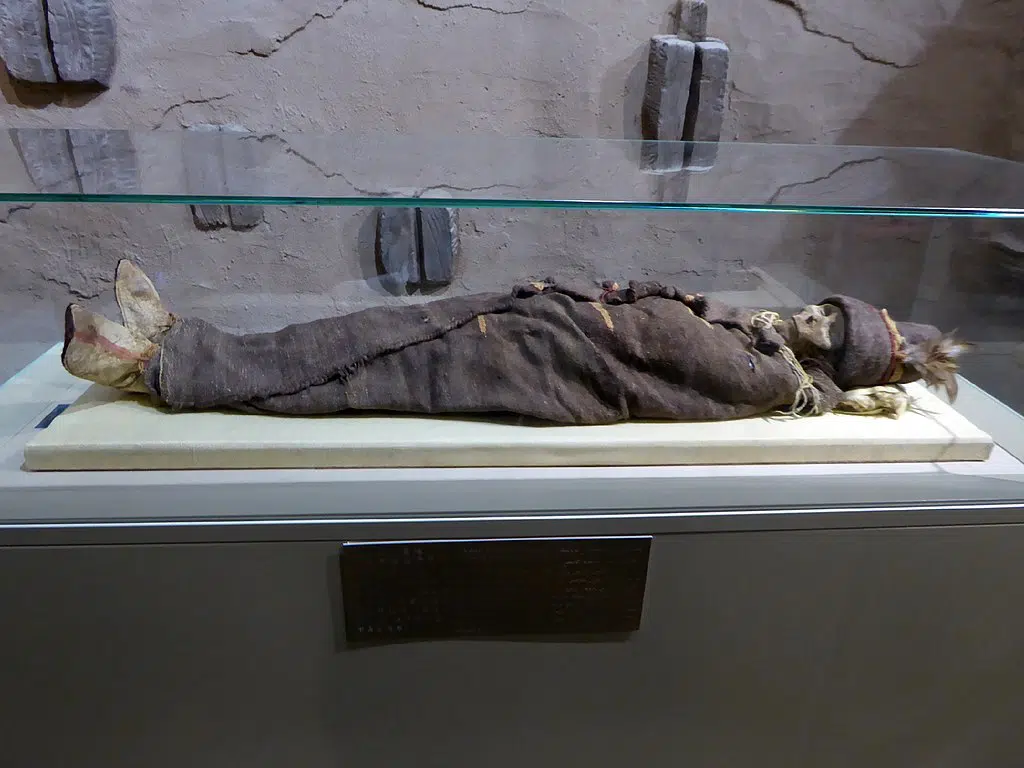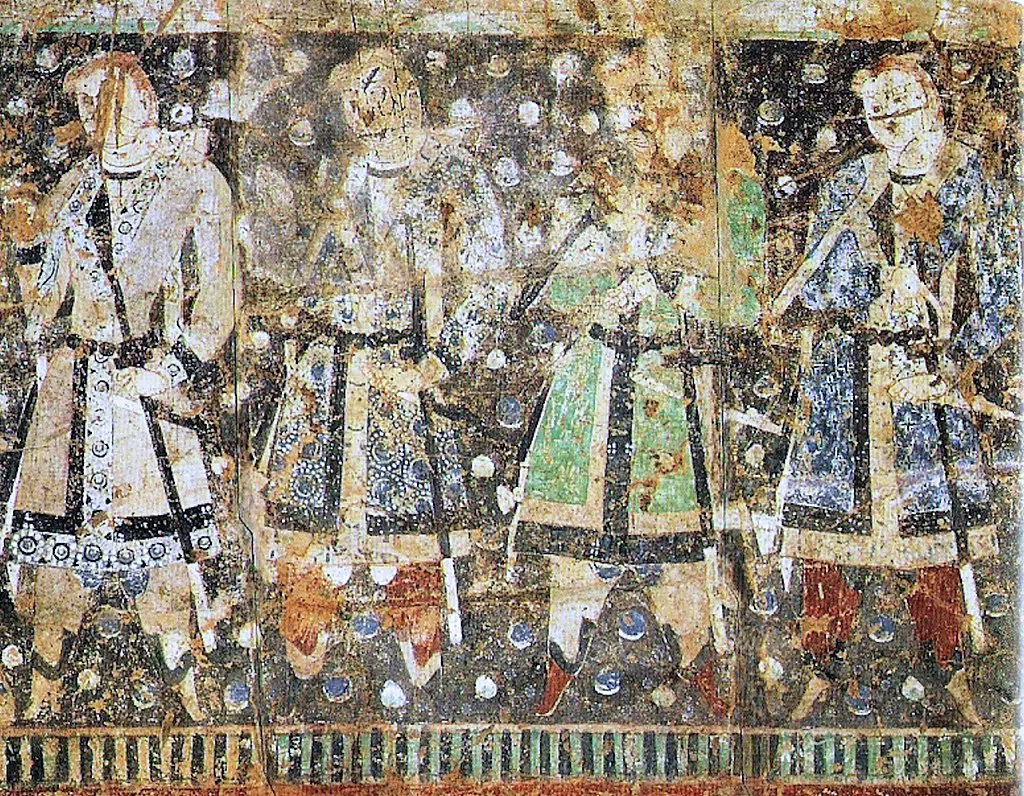
DNA studies on Bronze Age Tarim mummies found in China’s Xinjiang region revealed recently that not only were these people not descendants of Indo-Europeans that immigrated to the area — they may in fact be the ancestors of Native Americans.
With genes that are shared between them, people living in Siberia, and Native Americans, the “Tarim mummies” have now been proven to be clearly related to these groups, according to a study that was published in the journal Nature.
While scientists originally thought that they may have come overland from the West, the DNA sequencing showed that they actually had origins near where they were found, in the deserts of western China.
Tarim Mummies are link to Native Americans
Buried in boat-like wooden coffins, with their graves at the Xiaohe cemetery marked by upright wooden stakes that resemble oars, the mummies were part of a unique culture.
Their Bronze Age culture was not part of a remote branch of early Indo-Europeans, according to the research, as reported this week in Live Science.
The new DNA research belies the nearly-century long theories regarding the origins of the prehistoric people who lived in the Tarim Basin. As recently as the year 2000,
historians stated that there may have been at least two Caucasian groups into the Tarim Basin in the distant past. They associated these peoples with the Tocharian and Iranian (Saka) branches of the Indo-European language family, respectively.
Many archaeologists believed that the mummified remains belonged to the descendants of Indo-Europeans who had migrated to the region sometime before the year 2000 B.C.
However, now researchers know beyond a shadow of a doubt that these people, whose mummies were uncovered in the early twentieth century, were a genetically isolated group who apparently were not related to any nearby populations.
Tarim population lived along oasis-like rivers fed by mountain streams
Study co-author Christina Warinner, an anthropologist who teaches at Harvard and the Max Planck Institute for the Science of Human History in Germany, states in an interview with Live Science, “They’ve been so enigmatic. Ever since they were found almost by accident, they have raised so many questions, because so many aspects of them are either unique, puzzling or contradictory.”
As so often happens with hard science, the news upends all of what was previously almost taken for granted about the subject.
“It turns out, some of the leading ideas were incorrect, and so now we’ve got to start looking in a completely different direction,” Warriner admitted.
Although the graves were found by a hunter in an area that is now sandy and arid, it was once verdant, perched along the banks of a river, four thousand years ago.
Their wooden coffins were covered with cowhide, entombing the remains of the people for millennia after the climate changed to become much more arid.
Once with a total of over 300 people, a number of the Bronze Age cemetery’s tombs had already been looted by grave robbers before it was discovered in the early 1900s.

Europeans first to find Western China mummies in early 1900s
European explorers were the first to come upon the initial Tarim mummies in the Taklamakan desert of western China at that time; having what appeared to be red or fair hair and non-Asian features, it was naturally thought that these people were from the West.
But the recent research, on just the mummies that were in the Xiaohe tomb complex on the eastern edge of the Taklamakan, shows that they indeed were not from far away, although they remained in a distinct group genetically for some time.
In another unique trait, some of the mummies had been found with pieces of cheese around their necks, perhaps signifying food that they would need as they journeyed through the afterlife, according to the report.
Although some had originally thought that their origin was in Siberia, and that they had spoken an early form of Tocharian, an Indo-European language spoken in the northern part of the region after the year 400 AD, that cannot be the case, according to these new DNA findings.
Delta DNA from 13 of the oldest mummies, from about 4,000 years before the present, indicates that there was no genetic mixing with any nearby peoples, according to author Choongwon Jeong, who is a population geneticist at Seoul National University in South Korea.
Ancient North Eurasians disappeared as a separate people 10,000 years ago
The researchers now state that the Tarim people descended from Ancient North Eurasians (ANE), people from the Pleistocene era who had disappeared for the most part approximately 10,000 years ago, just after the end of the last Ice Age, when glaciers were melting all over the Northern Hemisphere.
Genes from these ANE individuals now exist only in the genomes of some present-day peoples — namely, among indigenous people in Siberia and the Americas, according to the researchers.
These weren’t the only mummies to have been found in western China; the new DNA research also looked at the genes of the Tarim mummies compared to those of the mummies from the same time that wee discovered in the Dzungarian region in the north of Xinjiang.
However, this population lived on the other side of the imposing Tianshan mountain range, which divides the region in two.
They discovered that the ancient Dzungarian population, unlike the Tarim, who lived approximately 500 miles (800 km) to the south, were descended from both the indigenous ANE people and the sheepherding peoples who lived in the Altai-Sayan mountains of southern Siberia called the Afanasievo.
This latter group of people had strong genetic links to the early Indo-European Yamnaya peoples who lived in what is now southern Russia, according to the researchers.
They believe that migrating Afanasievo herders who may have been following their herds had migrated and mixed with local hunter-gatherers in Dzungaria. Meanwhile the “Tarim people retained their original ANE ancestry,” Jeong told Live Science.
Area was a cultural — but not genetic — crossroads
“We speculate that the harsh environment of the Tarim Basin may have formed a barrier to gene flow, but we cannot be certain on this point at the moment,” he added.
The Tarim Basin already served as a crossroads of cultural exchange between the East and the West in the Bronze Age, the scientist state, and this would be the case for “thousands of years” into the future.
“The Tarim people were genetically isolated from their neighbors while culturally extremely well connected,” Jeong explained.
Strikingly, they had adopted many of the practices that settled peoples already engaged in, including “herding cattle, goats and sheep, and of farming wheat, barley and millet,” he said.
“Probably such cultural elements were more productive in their local environment than hunting, gathering and fishing. Our findings provide a strong case study showing that genes and cultural elements do not necessarily move together,” Jeong concluded.
Although surrounded by desert at the time, Warinner explained that the Tarim lived along ancient rivers that brought vital water supplies to some parts of the region — while the rest remained a desert. “It was like a river oasis,” she stated.
Showing just this scenario was once the case, pieces of ancient fishing nets have been found at Tarim sites; naturally, this also ties in to their practice of burying people in boat-shaped coffins. These, along with the warlike poles that marked their graves, seemed to have been created as an acknowledgement of the rivers that gave them life.
Getting their water from seasonal snow melt from the gigantic mountains nearby, the rivers often changed course after especially heavy snowfalls during the wintertime, the researchers say. When that did occur, they posit, the villages of the Tarim Basin would be basically cut off from their vital water supply. This very well may have been what caused the collapse of the culture in their area; now the region is almost all desert.
See all the latest news from Greece and the world at Greekreporter.com. Contact our newsroom to report an update or send your story, photos and videos. Follow GR on Google News and subscribe here to our daily email!



